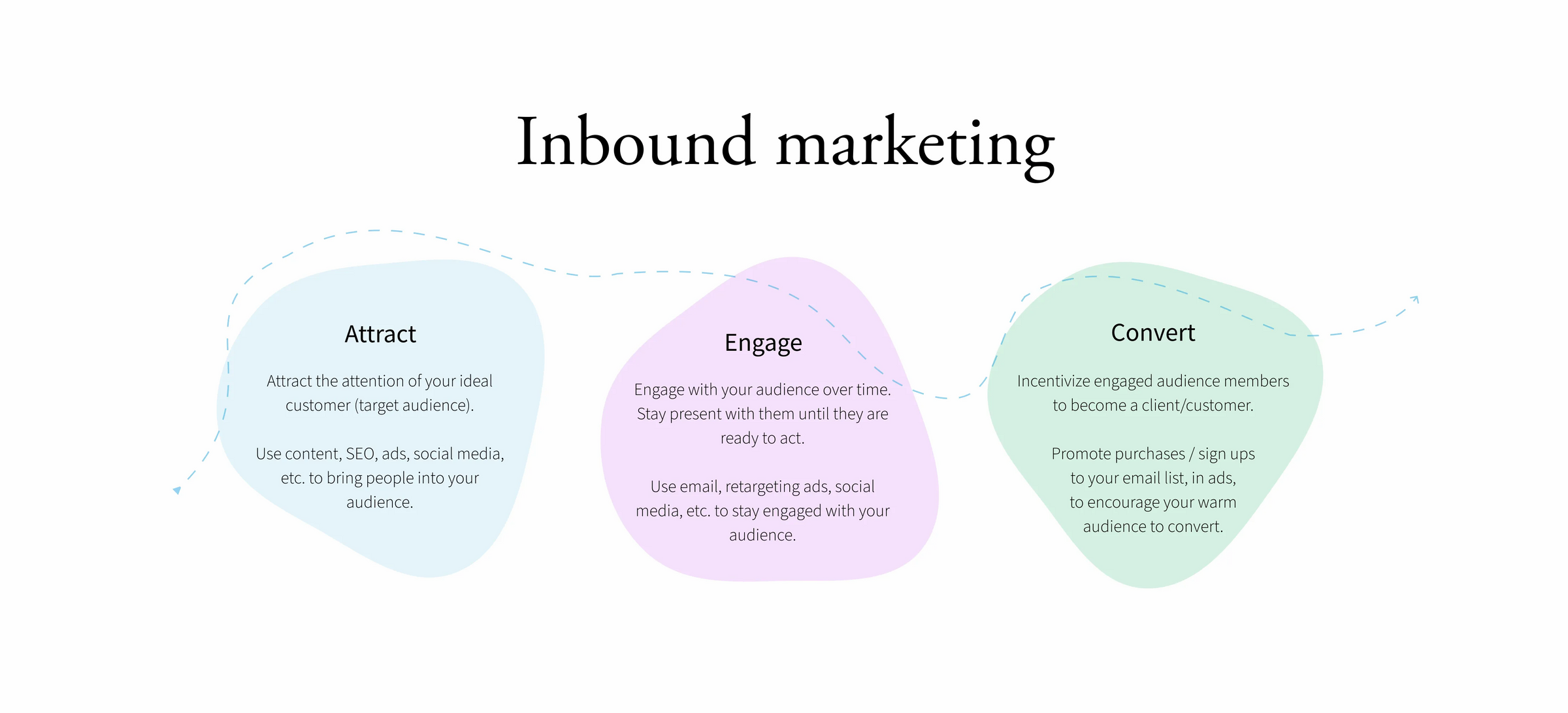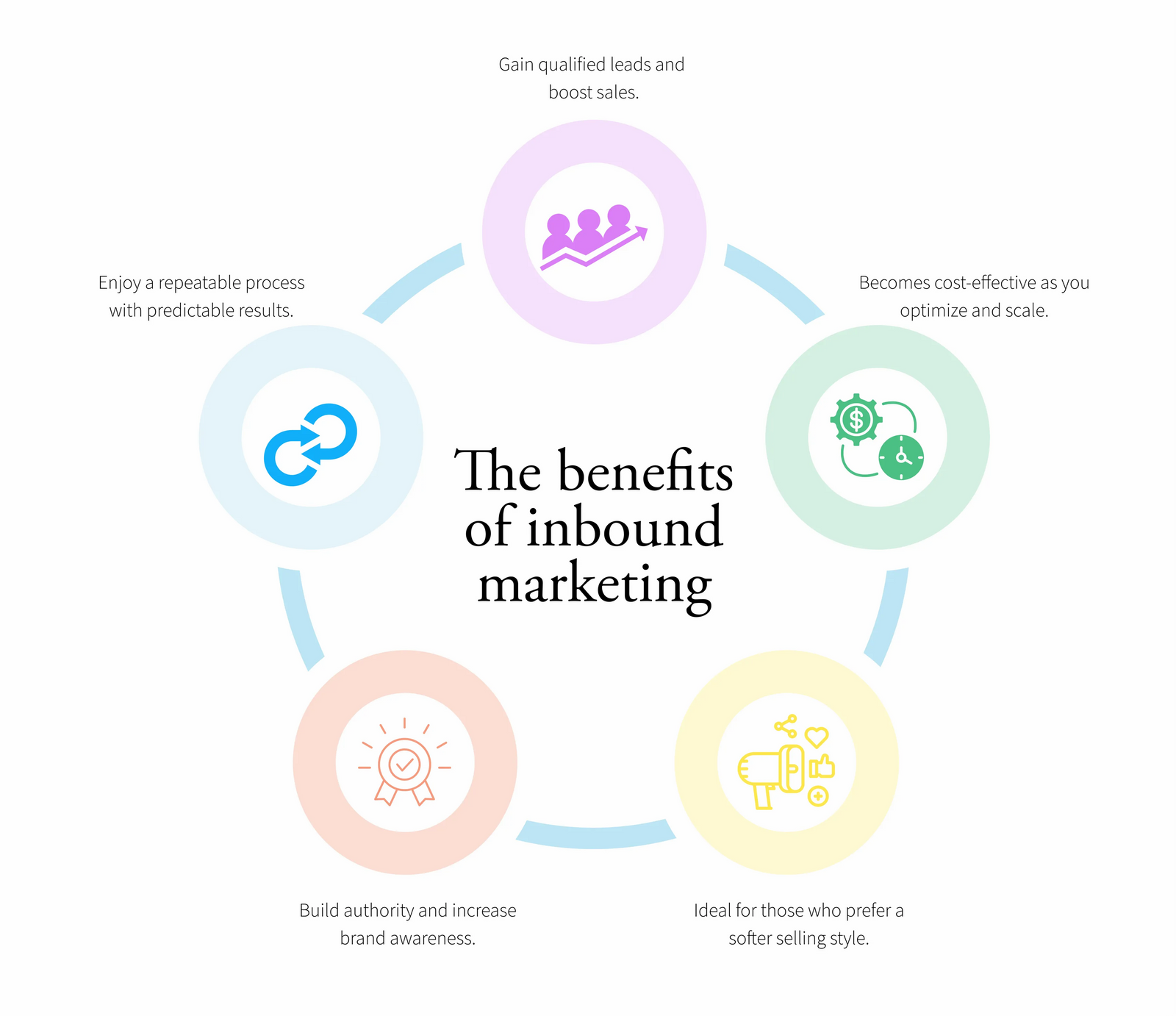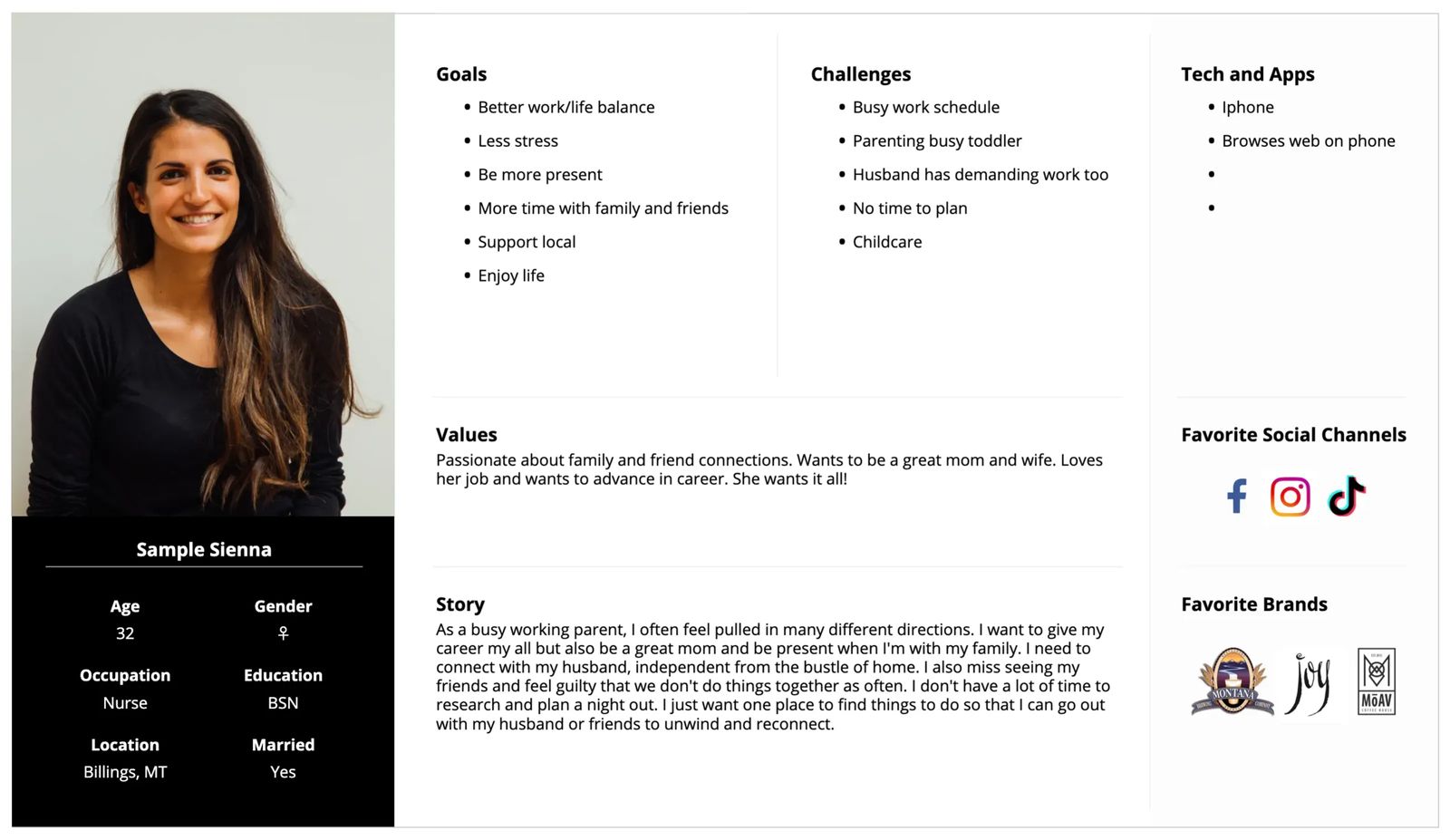
Inbound marketing for small business success
Jessica Baldwin / Published July 6, 2023
Are you an entrepreneur looking to grow your small business? Navigating the marketing world and finding the right strategies to reach your target audience can be overwhelming. With so much online information, it's easy to feel lost and unsure of where to start.
Having a clear marketing strategy is crucial for your small business. It helps define your target customers, understand their needs and preferences, connect and engage with them, and generate leads and sales.
It's important to recognize that every business is unique, and what works for one may not work for another. Different businesses operate in different industries, have varying target audiences, and offer distinct products or services. Therefore, it's essential to tailor your marketing approach to suit your specific business needs and goals.
If you'd like to generate more leads and sales online, inbound marketing is a strategy you should understand and consider.
What is inbound marketing?
Inbound marketing is a strategy that aims to attract and engage potential customers by providing them with valuable content and experiences. This approach involves various tactics such as content creation, search engine optimization (SEO), social media marketing, email campaigns, and pay-per-click advertising.
The primary goal of inbound marketing is to capture the attention of your target audience and maintain a lasting connection with them. By consistently delivering high-quality content and meaningful interactions, businesses can become a brand their audience wants to buy from.

Inbound marketing is particularly effective for small businesses that offer low to mid-priced products or services that can be easily understood and purchased online. However, implementing an inbound marketing strategy requires dedication and continuous effort to reach a sizeable audience and build brand awareness.
Using inbound marketing techniques, you can establish your business or personal brand as a thought leader, build trust with your target customers, and ultimately drive more conversions and sales. Whether creating informative blog posts, optimizing website content for search engines, or nurturing leads through email marketing campaigns, inbound marketing can help businesses thrive.
The benefits of inbound marketing
Discover the advantages of incorporating inbound marketing into your small business's marketing efforts. Here's why you should consider leveraging this strategy:

1) Enjoy a repeatable process with predictable results.
Inbound marketing follows a systematic approach that can be replicated over time, ensuring consistent outcomes. By continually creating valuable content and engaging with your audience, you can attract a steady stream of potential customers and generate reliable leads.
2) Gain qualified leads and boost sales.
Inbound marketing focuses on attracting and engaging your target audience rather than reaching a broad, uninterested demographic. This approach leads to highly qualified leads, resulting in improved conversion rates and increased sales for your business.
3) Achieve cost-effectiveness as you optimize.
Inbound marketing becomes cost-effective over time because it helps businesses generate organic traffic, build strong relationships, and use data to improve their strategies. Although it requires an initial investment of time and resources to create valuable content, the long-term benefits include lower marketing costs and higher return on investment. By consistently creating valuable content and engaging with their audience, businesses can reduce expenses and see increased profitability over time.
4) Build authority and increase brand awareness.
By consistently delivering valuable content that addresses the needs and challenges of your target audience, your small business can establish itself as an industry expert. This helps build trust, authority, and brand awareness, making it more likely for potential customers to choose your products or services over competitors.
5) Ideal for those who prefer a softer selling style.
If you're not confident with a proactive outbound sales approach, inbound marketing provides a more subtle and educational path. By allowing customers to seek information voluntarily, you can build trust and establish meaningful connections with your audience.
By implementing effective inbound marketing tactics, you can reach your target audience, generate leads, and ultimately grow your customer base and revenue.
Additional considerations
Here are some important considerations to keep in mind when implementing an inbound marketing strategy:
1) Patience is key.
Strategies like SEO and content marketing require time to generate noticeable results. It may take several months to see significant organic website traffic and build momentum. Additionally, remember that the sales cycle for your product or service may be longer, requiring potential customers to take time before making a purchase decision after their initial interaction with your brand.
2) Focus on building a substantial audience.
Inbound marketing relies on reaching a wide audience at the top of the marketing funnel. Remember that only a small percentage of these individuals will convert into actual customers. Be prepared to engage with a large number of people before seeing significant results in terms of conversions and sales.
3) Embrace a holistic approach for effective inbound marketing.
Relying solely on your website or SEO efforts is insufficient. Inbound marketing requires a comprehensive marketing plan that utilizes various touchpoints and channels. Incorporate tactics such as social media marketing, email marketing, and content creation to create a well-rounded marketing funnel that engages potential customers at every stage of their journey.
4) Continuous learning is crucial.
Implementing an effective inbound marketing strategy demands diverse skills and knowledge, from content creation to SEO, email marketing, online advertising, and more. As a small business owner or solopreneur, it can be challenging to possess all the expertise required for successful execution. Consider seeking external resources like outsourcing specific tasks or investing in training programs to overcome skill gaps and ensure the strategy's success.
While inbound marketing offers significant benefits, it's important to remember that it takes time to yield results. By considering these factors, you can maximize the impact of your inbound marketing efforts and achieve long-term success for your business.
Inbound marketing example: Brandy's Bakery
Introducing Brandy's Bakery, our "sample" bakery known for its delectable treats and warm customer service. Brandy is eager to grow her business and attract more customers through an effective inbound marketing strategy.

Here's an example of how Brandy could implement inbound marketing tactics at each stage of the marketing funnel:
Attract
- Develop a content marketing plan: Brandy would create a blog on her website and regularly publish articles that provide baking tips, recipes, and insights into the world of baking. She would optimize for search engines to attract organic traffic.
- Engage on social media platforms: Popular platforms like Instagram and Facebook make it possible for Brandy to reach new potential customers. She would share visually appealing images of her bakery creations, engage with her audience through comments and messages, and actively participate in relevant baking communities and groups.
- Collaborate with influencers: Brandy would partner with influential food bloggers, baking enthusiasts, and local food influencers to feature her bakery products and share their experiences with their followers, increasing brand visibility.
Engage
- Offer a free downloadable recipe e-book: A high-quality recipe e-book is what Brandy uses as her lead capture. Visitors can download it from her website in exchange for their email address. As she builds her email list, she nurtures potential customers by providing valuable content.
- Host virtual baking classes: Brandy would conduct online baking classes where participants can learn new recipes and baking techniques. Brandy can establish herself as an authority in the baking industry by showcasing her expertise and fostering community while building relationships with potential customers.
- Implement retargeting ads: Retargeting ads allow Brandy to reach website visitors who have shown interest in her bakery. By displaying tailored ads on platforms like Facebook and Google, she can remind them of her delicious offerings and encourage them to take the next step.
Convert
- Create enticing offers: Limited-time offers, such as discounts or buy-one-get-one promotions, will help Brandy incentivize potential customers to purchase. These offers could be prominently displayed on her website and shared through email campaigns.
- Optimize the checkout process: A seamless and user-friendly online ordering experience is a priority for Brandy's website. She will offer a simple checkout process, multiple payment options, and clear product descriptions and pricing.
- Implement personalized email marketing: Brandy would send personalized emails to her subscribers, recommending products based on their preferences, previous purchases, or upcoming special occasions. This personalized touch can help drive conversions and encourage repeat business.
By implementing these inbound marketing tactics at each stage of the marketing funnel, Brandy's Bakery can increase brand awareness, engage potential customers, and ultimately convert them into loyal patrons of her bakery.
Inbound Marketing Example: Bright Balance Accounting
Introducing Bright Balance Accounting, our "sample" accounting firm focused on providing top-notch financial services and expert advice to small businesses.

Let's explore how Bright Balance Accounting could implement inbound marketing tactics at each stage of the marketing funnel:
Attract
- Create an educational blog: Bright Balance Accounting could establish a blog on its website and publish informative articles on topics like tax planning, bookkeeping best practices, and financial tips for small businesses. These articles would be optimized for search engines to attract organic traffic from business owners seeking financial guidance.
- Offer downloadable guides: To capture leads, Bright Balance Accounting could create downloadable guides or eBooks that provide valuable insights on topics such as financial management for startups or maximizing tax deductions for small businesses. Visitors provide their email addresses to access the guides, allowing Bright Balance Accounting to nurture them through email campaigns.
Engage
- Host webinars on accounting topics: Bright Balance Accounting could conduct live webinars or pre-recorded video presentations where they share expert advice on accounting topics relevant to small business owners. They could cover subjects like managing cash flow, understanding financial statements, or tax compliance for entrepreneurs. These webinars position Bright Balance Accounting as a trusted source of knowledge and foster engagement with potential clients.
- Collaborate with business influencers: Bright Balance Accounting could collaborate with influential business bloggers, industry experts, or local business influencers to create co-branded content, such as guest blog posts or joint webinars. These collaborations would help expand their reach and tap into new audiences who trust the recommendations of these influencers.
- Implement retargeting ads: Bright Balance Accounting could use retargeting ads on platforms like LinkedIn or Facebook to reach website visitors who have shown interest in their accounting services. By reminding these visitors of the value Bright Balance Accounting offers, they can encourage them to take the next step and inquire about their services.
Convert
- Offer a free consultation: Bright Balance Accounting could provide a free initial consultation to potential clients. This consultation would allow them to understand the specific accounting needs of the business owner and demonstrate their expertise and personalized approach. The goal is to convert these consultations into long-term client relationships.
- Send personalized email campaigns: Bright Balance Accounting could segment its email list based on the interests and needs of subscribers. They could send personalized emails with relevant content, such as tax planning tips, industry-specific financial advice, or updates on small business regulatory changes. These personalized emails would nurture leads and increase the chances of conversion.
- Optimize the website for conversions: Bright Balance Accounting would optimize its website's landing pages and contact forms to streamline the conversion process. Clear call-to-action buttons, persuasive copy, and user-friendly forms would make it easy for potential clients to take the desired action and reach out for accounting services.
By implementing these inbound marketing tactics tailored to the accounting industry, Bright Balance Accounting can attract potential clients, engage with them, and ultimately convert them into loyal clients who rely on their expertise for their financial needs.
How to create your inbound marketing strategy
Creating an effective inbound marketing strategy for your small business requires careful planning. Here are some tips to help you get started:
Define your ideal customer
An effective marketing strategy will communicate your brand's message to your ideal customer. It's crucial to develop your ideal customer persona. A customer persona is a representation and profile of the type of person you want to attract to your brand. It helps you understand your target audience better and tailor your marketing efforts accordingly.

By identifying your target audience and creating a customer persona, you can customize your website, content strategy, target keywords, social media channels, and online marketing campaigns to cater to their interests and preferences. This enables you to create valuable and relevant content that resonates with your ideal customer, effectively capturing their attention and driving engagement.
Here's how to define your ideal customer persona.
Set goals
Goals provide direction, focus, and a clear understanding of what you want to achieve. When setting goals for your inbound marketing, consider both short-term and long-term objectives.
Short-term goals can include increasing website traffic, generating leads, and building brand awareness. These goals help create a solid foundation for your inbound marketing efforts and allow you to attract potential customers to your website or social media platforms.
Long-term goals may include nurturing leads, increasing customer loyalty, and driving revenue growth. These goals focus on building lasting relationships with your target audience and turning them into loyal customers who actively engage with your brand.
Regularly monitoring and analyzing your progress towards these goals using tools like Google Analytics can help you refine your strategies and make data-driven decisions. Adjusting your goals based on the insights you gather will allow you to optimize your inbound marketing efforts and maximize your chances of success.
Map the customer journey
What path will people take to become your customer?
What steps will they take? How can your marketing guide this process? For example, someone's first exposure to your brand may be to watch one of your YouTube videos. How will you get them to subscribe, visit your website, or sign up for your newsletter?
Your customer will take many small steps with your brand before they purchase. They may follow you on social media, visit your website a few times, read online reviews, sign up for your newsletter, etc.
Identify the logical path people will take. Then, develop your marketing funnel to guide your prospects through the steps.
Organize your marketing plan into three stages: attract, engage, and convert
Creating an effective marketing plan involves organizing your efforts into three key stages: attract, engage, and convert. Each stage guides potential customers through their journey, from discovering your brand to becoming loyal customers. Let's explore how you can optimize each stage to maximize your marketing impact.
Attract
The first step is to attract your ideal customers and make them aware of your brand. Here are some strategies to consider:
- Enhance your website's visibility through SEO practices, optimizing your content for relevant keywords.
- Utilize the power of social media by creating engaging posts, leveraging influencer partnerships, and running targeted ads.
- Expand your reach with online advertising platforms beyond social media, such as Google Ads or Bing Ads, to capture potential customers actively searching for products or services like yours.
Engage
Once potential customers discover your brand, the next stage is fostering engagement and building trust. Here are a few techniques to keep them interested:
- Implement a robust email marketing strategy that delivers valuable content, exclusive offers, and personalized recommendations based on customer preferences.
- Harness the power of retargeting ads to stay top-of-mind with potential customers who have interacted with your brand, reminding them of your products or services.
- Host webinars, live streams, or interactive Q&A sessions to showcase your expertise, provide value, and create a community around your brand.
Convert
Converting engaged prospects into paying customers is the ultimate goal. Here are some approaches to increase your conversions:
- Create irresistible special offers, discounts, or loyalty programs that give customers a clear incentive to choose your brand over competitors.
- Optimize your website's sign-up and checkout process, ensuring a seamless, user-friendly experience with minimal steps and intuitive navigation.
- To build trust and credibility, leverage social proof by showcasing positive customer reviews, testimonials, or case studies.
Measure and refine
Remember to regularly measure the effectiveness of your marketing efforts and refine your strategies based on data-driven insights. Track key performance indicators (KPIs) such as website traffic, conversion rates, email open rates, and customer feedback to improve your marketing plan.
By following these guidelines and continuously adapting your approach, you can create a marketing plan that successfully attracts, engages, and converts potential customers, helping your business thrive.
Inbound marketing: is it right for your business?
Adopting an inbound marketing approach can significantly contribute to the success of your small business. It's important to recognize that inbound marketing requires patience, which involves building relationships and trust with your audience over time. There may be a period of trial and error as you experiment with various strategies and tactics to find what works best for your business. Additionally, growing a sizable audience demands resources and consistent effort.
However, the beauty of inbound marketing lies in its scalability. Once you discover a winning formula and deeply understand your audience's preferences and needs, you can amplify your efforts and scale your business. By persistently refining your digital marketing strategies, staying adaptable, and leveraging the power of inbound marketing, your small business can thrive, attract a loyal customer base, and experience sustainable growth in the dynamic online landscape.
For more help on this topic, check out our webinar titled, "Win Customers with Your Website!"
Free workbook: Win customers with your website!
Create a strategy to get more leads and sales from your website.







